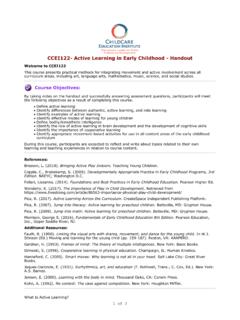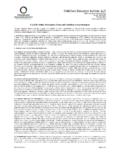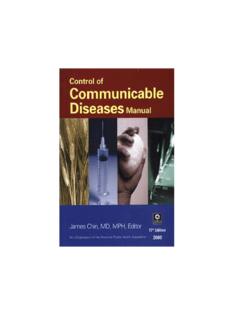Transcription of CDA ASSESSMENT OBSERVATION INSTRUMENT - …
1 Bilingual Specialization: Yes NoMarch 1999 Name of AdvisorCandidate Name Social Security # OBSERVATION SiteDate(s) of ObservationSetting:PreschoolAges of children# of childrenFamily Child CareAges of children# of childrenInfant ToddlerIndicate number of children and age group in Candidate's care (observedusing this INSTRUMENT ):Young Infants _____Mobile Infants _____ Toddlers _____If the Candidate was not observed with all 3 age groups, indicate numberof children and age group/s observed during the SupplementalObservation to complete the Advisor OBSERVATION requirement:Young InfantsMobile InfantsToddlersCDA ASSESSMENTOBSERVATION INSTRUMENTP reschool, Infant/Toddler, Family Child CareStatement This Advisor OBSERVATION INSTRUMENT is complete and in compliance with the CDA requirements for thisassessment. Advisor s SignatureDateCDA ASSESSMENT OBSERVATION Instrument2 InstructionsThis CDA ASSESSMENT OBSERVATION INSTRUMENT is used by Advisors as part of the CDA Candidate Assessmentprocedure.
2 Through its use, many of the more observable aspects of competence required of a CDA can be addition to OBSERVATION , Advisors may interview Candidates and use other knowledge of the Candidate s workwith children to complete this OBSERVATION can be used either in a family child care home or a center-based setting. It is meant to be completedwhile observing the Candidate working as the primary caregiver with a group of Procedures for completing the observation1. Scheduling the OBSERVATION :The Advisor is required to spend as much time observing the Candidate as it takes to complete this may be accomplished in one visit, or it may require several observer should plan to spend at least 2 to 3 hours watching the Candidate work. In full-dayprograms, mornings are generally the best time for an OBSERVATION , but afternoon observations are possiblein programs where children's schedules are very active during the afternoon hours.
3 An example of a programwhere an appropriate sample of the Candidate s performance could be observed during an afternoon is aninfant program that has individualized schedules so that some of the children are awake throughout theday. In half-day programs, schedule the OBSERVATION for a time when the program normally meets. Allobservations must be done within the six months prior to the time the Candidate submits the DirectAssessment Application Before observing:a. So you will know what to look for, read the OBSERVATION INSTRUMENT thoroughly before observinga Enter the information on the cover While observing:a. Be as inconspicuous as possible. Remember that you are trying to collect information on how theCDA Candidate works with children. Therefore, listen and watch. Of course, you should becourteous if children approach you, but try to avoid interacting with children, asking questions, orinterrupting in any way.
4 Keep note of any questions you have for the CDA Candidate and save themuntil after the Before actually observing the Candidate, spend 10 to 15 minutes becoming familiar with thesetting you are around as needed while observing. Be sure to observe both the CDA Candidate s interactionsand the children s experiences, as well as aspects of the physical If more than one adult is working with the group being observed, concentrate your attention onlyon the CDA Candidate s scale: 1-rarely, 2-sometimes, 3-mostly34. After you complete the OBSERVATION (s) the rating for each item on the Summary Score Sheetb. Place this CDA ASSESSMENT OBSERVATION INSTRUMENT in a sealed envelope and give it to theCandidate for the final Verification OBSERVATION INSTRUMENT guidelines1. RatingYour OBSERVATION provides critical information regarding Candidate performance.
5 Bring to bear your mostdiscriminating professional judgment when entering will rate the Candidate s performance on a series of items in each Functional Area. Your rating willindicate whether the Candidate s performance on the item occurs rarely, sometimes, or most of the deciding on your rating, however, you will check off some specific indicators of Candidate sperformance that you OBSERVATION INSTRUMENT is organized in the following way: Each item to be rated is numbered. Numbered items describe general aspects of Candidateperformance that represent competence. Next to each item is a box. You will rate the Candidate bywriting the number 1, 2, or 3 rating code in this box.[1]Rarely. As you observed the Candidate, you were unable to witness evidence of this action beingtaken, or you observed evidence infrequently, or actions taken were inappropriate.
6 [2]Sometimes. You were able to observe some evidence of the action.[3]Mostly. The Candidate demonstrated repeatedly the behavior described. You observed muchevidence that the Candidate was acting in a competent All toys and materials provided for use by children are safe. Below each numbered item is one or more indicator statements. These describe more specific aspectsof competence that are expected of the Candidate. You are to look for these statements and check offeach as you observe the Candidate s performance. Check only if they have relevance to the situation/setting/individual you are observing. All statements need not be checked to determine a rating. Thecheck mark does not indicate an affirmation of positive performance, but rather that you haveconsidered this aspect during this All toys and materials provided for use by children are and materials are safe for children s developmental ASSESSMENT OBSERVATION Instrument4 Examples are also provided as samples of what to look for.
7 They are not required and it is possible foran indicator to be checked even if a specific example is not observed. Every age level and setting aredifferent. Always look for alternate examples of ways in which an item can be All toys and materials provided for use by children are and materials are safe for children s developmental unbreakable baby toys too large to swallow; no pillows or heavy blankets for babies; sturdypreschooler s toys; all materials non-toxic2. During the OBSERVATION visit, you are to look for indicators of competence, checking off statements as yousee them. Remember, examples are samples of what to look for but are not required. Generally, indicatorswill not be checked off in the order in which they appear in the Once you have enough indicators checked off to form an opinion of the Candidate s performance overtime, rate the Candidate on the numbered items by writing the 1, 2, or 3 rating code.
8 If all indicators arechecked, it is likely, but not necessary, that the item will be rated a 3. However, an item may be greaterthan the sum of its parts. All indicators might be checked while the item may still be rated a 2 or a 1. Someitems may have to be rated after you have reviewed your notes and had a little time to think about For every item, explain your rating in the comments section. Note brief examples of what the Candidatedid or did not do. Also note any peculiar circumstances that prevent the Candidate from complying with Each item should be rated by the time your OBSERVATION is completed. If you are not able to rate everyitem based on what you observe, then it will be necessary to ask the Candidate interview questions tocomplete rating of those If the Candidate s rating is based on what the Candidate says, rather than what you observed, write I for interview in the comments section.
9 Write down the question you asked and the Candidate s this follow-up interview, ask open-ended questions that are not threatening and do not lead theCandidate to an answer. For example, if you need information on naptime you might ask, How is naptimeusually handled? Listen carefully to the Candidate s response, record pertinent information, and rate theitem, based on all the relevant information you have Following each Functional Area section, space is provided for additional items. In that space, list anyadditional aspects of the Candidate s competence that you observed which relate to the competence in theFunctional Area, but which can not be categorized under the existing items. Number each item, rate theCandidate using the 1, 2, or 3 rating code, and explain your rating by writing indicators or examples Completing Functional Areas 12 and Functional Areas are not directly observable.
10 Comments on these indicators may be based upon aninterview with the Candidate. You may need to schedule additional time to conduct this scale: 1-rarely, 2-sometimes, 3-mostly5 This page intentionally left ASSESSMENT OBSERVATION Instrument6 FUNCTIONAL AREA 1: SAFEC andidate provides a safe environment to prevent and reduce All toys and materials provided for use by children are Supervision is appropriate for the developmental level of are always attended by authorized and amount of supervision is based on thedevelopmental needs of children in adult stays closer to babies and toddlers than to preschoolersVery close, attentive adult supervision is used in typicallydangerous situations, indoors and child on changing table, in bath or wading pool; crossingstreet; areas of playgroundAdult maintains enough control so children do not hurteach are protected from any safety risks present in broken toys, equipment, or furnishings are removed; outletscovered with safety caps; children kept away from broken play-ground equipment; broken glass removed from play areas out-doors; heating units or low windows blockedEx.














